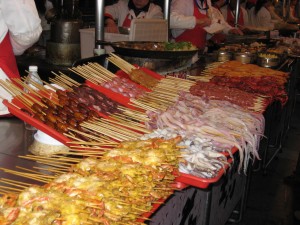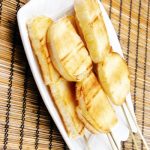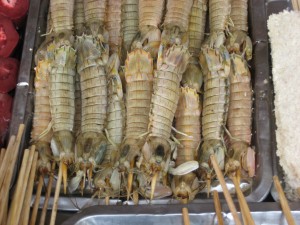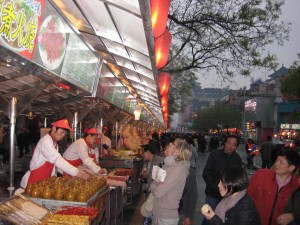Chuànér (串儿) Posted by Stephen on Feb 11, 2012 in Culture
 Quite similar to the Middle Eastern style of “kebab”, 串儿 (Chuànér) is a skewer of grilled anything, meant to be eaten without utensils or modesty. To me, 串儿 is more than just a snack, it’s a state of mind, enjoyed by all ages and all walks of life. Synonymous with night-life dining culture, 串儿 is like the Chinese version of tapas. It’s the foundation to any late-night meal, encouraging conversation, drinking and midnight antics.
Quite similar to the Middle Eastern style of “kebab”, 串儿 (Chuànér) is a skewer of grilled anything, meant to be eaten without utensils or modesty. To me, 串儿 is more than just a snack, it’s a state of mind, enjoyed by all ages and all walks of life. Synonymous with night-life dining culture, 串儿 is like the Chinese version of tapas. It’s the foundation to any late-night meal, encouraging conversation, drinking and midnight antics.
The beauty of 串儿 lies in it’s simplicity, requiring only a heat source (often a coal or wood fired grill or electric oven), chunks of meat, tofu, vegetables or even a starch, some kind of skewer, and an assortment of spices to add flavor. It can be cooked by anyone with a little practice, on any street corner, and you’ll find it any time during the day or night. Think of it as comfort food for the entire population of China and any 老外s lucky enough to disregard the travel clinics orders. Just grab a stick and chow down (吃吧)!


Everything about 串儿 is convenient, even the character for it. *Please note here that Beijing and northern regions of China add the 儿 (hard r sound) due to dialect, but in southern regions people often just say 串 and drop the 儿*. That being said, the basic character in chuàn, 串,pictographically looks just like an example you’d find at a grill (see left). The line down the middle represents the skewer, and the two boxes represent the meat, bread, veggie, tofu that you are grilling.
It’s not surprising that Han Chinese culture has taken a liking to this 新疆 style of food because Chinese people love food that is convenient 方便 [fāngbiàn], and mobile. While most 新疆串儿 is lamb or chicken based (due to Muslim culture they do not eat, or have the same affinity for pork, 猪肉 zhūròu, as the Han Chinese), the Han Chinese have elevated 串儿 to a whole new level (phrase: 提高水平).

In coastal regions (especially in Taiwan), squid 串儿 is the most common delicacy. You’ll often find it with a sweet, chalky bbq sauce that can really be hit or miss. You can also get all sorts of 鱼 [yú] 串儿,mostly deep fried and still with bones. Then, for the most adventurous, there is sea snake (not too tasty in my opinion), shark (really just dogfish), starfish, sea urchin and even sea cucumber 串儿。
If you’re in an inland setting, the most common style of 串儿 is almost always going to be fatty pork (猪肉 zhūròu) or lamb (羊肉 yángròu). Simplistic? Yes, but like all staples of Chinese food, necessarily so because it’s just so darn delicious. With lamb or pork 串儿,chunks of meat are separated by grizzle and fat, which melts into the meat during grilling, creating the most melt-in-your-mouth texture and flavor. Better yet, while the fat sizzles, spices are generously dumped atop the 串儿 and soak directly into the meat crystalizing the flavor in.
Many Chinese people have told me that the fat is indeed the best part of the 串儿, and you’ll soon realize this when you go out to eat in China. While for many 老外, grizzle is a texture we dislike, for Chinese people have grown love gnawing upon parts of the meat we would usually throw out because for centuries it was a sign of affluence and nourishment. Chinese people see a meal of fatty meats with friends as a celebration of good fortunes after nearly a half century of starvation. Chinese people revel at the chance to not only eat the fattiest cuts of meat possible, but to share them with guests. So 老外, show some manners and “chew the fat” 聊天或闲谈 [liáo tiān huò xián tán] with some 朋友s.
For vegetarians the options are much more limitted, but still delicious. 馒头票 or 馒头串儿 (toasted steamed bun with oil) is one of my personal favorites, and oh so 便宜 (cheap). Fried tofu (豆腐)is also an option, but can be rather hit or miss depending upon where you go. The grilled vegetables, however, seem great no matter where I go. My absolute favorite, 辣椒串儿 or [làjiāo](think spicy green chili) is perfect when you need a little pick me up (I call it green tea on a stick).

Yet for those truly willing to try something new, I suggest taking a stroll down 王府井 street market in Central Beijing. Known for it’s “exotic” food, 王府井 is home to some of the most bizarre and tasty 串儿 I’ve ever eaten. As you traverse the street, you’ll be accosted by 小贩 [xiǎofàn] or street vendors yelling and pointing the their assorted “things on a stick”. For clips and a virtual tour, click here.
My favorite exotic snack here is undoubtedly the fried scorpion on a stick or 蝎子串儿 [xiēzi]. Just think of it as deep friend popcorn, as it is very oily, crunchy and has a starchy inside. Maybe even more enjoyable than eating these nasty little creatures, is watching how they are prepared and cooked. Shoved onto a skewer while still alive, they’ll twitch and flex their stingers while you walk by, allowing you to pick the feistiest ones for your stomach 肚子. Check out the video Now that’s good 蝎子!
Follow steve on twitter: @seeitbelieveit

Build vocabulary, practice pronunciation, and more with Transparent Language Online. Available anytime, anywhere, on any device.
About the Author: Stephen
Writer and blogger for all things China related. Follow me on twitter: @seeitbelieveit -- My Background: Fluent Mandarin speaker with 3+ years working, living, studying and teaching throughout the mainland. Student of Kung Fu and avid photographer and documentarian.




Comments:
Weber Q240 Grill:
Happy Grilling!
Weber Q240:
Wow this is a actually a wonderful piece of writing, I concluded this is a serious place to come for reading. Once you called this article like that what inspired you? Where does your inspiration appear from to write these terrific articles ? Thank you.